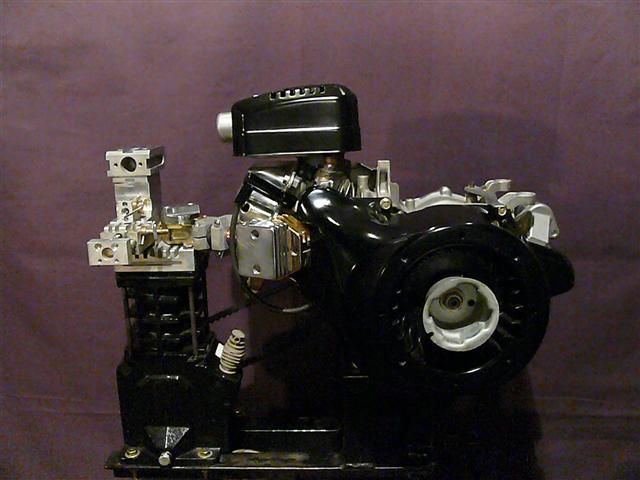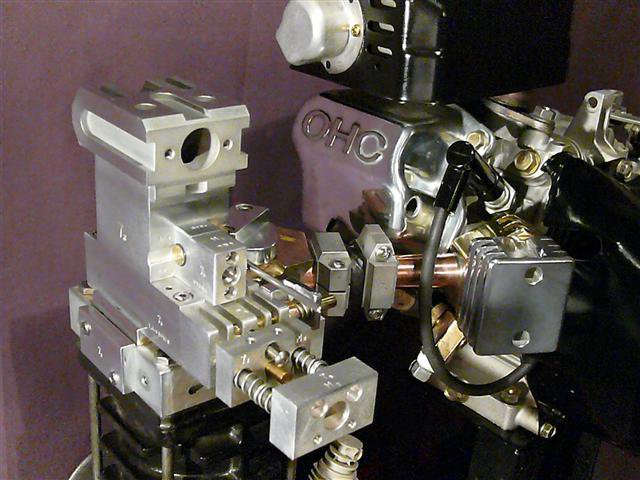|
A Portrait of an Inventor
Oklahoma’s Native Engine Pioneer Is also a Texan THOMAS ALLEN GRAVES; AUSTIN, TX; 10/23/2019; A Green Country Genesis It’s been more than four decades since a little cowboy that was often to be found riding his horse around Sand Springs, Oklahoma began to build his first engines. It all begins with a boy that was crazy about the alphabet and books. He’d spent a lot of time reading at the town square in the shadow of the Charles Page statue. By the time he was 7 or 8 years old he had been through everything in the Charles Page Memorial Library that resembled a science book, including ancient British, and Latin books that had been long forgotten in the basement. He was fascinated with Oklahoma’s factories, farms, and the ornate architecture of Tulsa. His family had the biggest white two-story house on Broad Street and His family land was west of Sand Springs on a peninsula called Eagleshead Island, at Shell Lake. It was at Eagleshead Island that he felt most at home. Near Eagleshead Island was Eaglesnest Airfield. Sometimes the boy would hang around Eaglesnest Airfield just to study the airplanes or talk to the pilots and mechanics. The Oklahoma Green Country region and especially Sand Springs had a strong tradition of hot rodding and racing. The boy was always happy to learn things from any of the hot rodders that would take the time to tell a cowboy a thing or two. Sometimes, even NHRA Champion Bennie Osborn would take the time to talk. During elementary school he would often walk the long way around Central Elementary School in order to walk through the adjacent middle school’s doors on W. 4th Street because the term “MANUAL ARTS” was proudly carved in the capstone above them. The boy showed an intense interest in manual arts. He was able to do things like running a backhoe and soldering pipes at a very early age. He also wrote science books. Two of those books, one about “Fluid Mechanics and the Westinghouse Air Brake System”, and one about “Dinosaurs” would be displayed in the elementary school hall showcase for at least 2 decades after they were written. This little cowboy was called Tommy Allen, and today he is known as TAG or Thomas Allen Graves. Graves is an Inventor with an extensive history in applied and experimental physics. His experiments in fundamental heat engines date back to his childhood days. He pioneered sealed-volume hydrogen/oxygen engines then subsequently built the earliest supercharged OHV 2-stroke engines known to exist. An EPIC adventure In the early 1990’s Graves began working in the field of sealed-volume hydrogen/oxygen engines that became his “Electric Powered Internal Combustion” or EPIC engine science. EPIC engines were eventually evolved to include air breathing variants. Graves says,” EPIC is the true fundamental hydrogen/oxygen engine science. It is as basic to a hydrogen/oxygen engine as pneumatics are to a compressed air tank. Metaphorically speaking, you can’t leave home without it.” Graves named the air breathing technology Captive Pulse engine science and in the early 2000’s he built the world’s first Captive Pulse engine in Manchaca, Texas. A long-time lab assistant Steven Lewis Edward pushed the ignition button for the first time as he pronounced “Let there be Captive Pulse!”, and instantly a new engine science came to life. Soon a larger “free piston” type reciprocating OHV 2-stroke ICE. This engine included the earliest known piston integrated OHV controlled positive displacement supercharger and an engine control that fires the engine on demand from a dead stop, and up to any given speed. This engine was tested in various modes for thermal efficiency at Chatleff Controls in Buda, Texas by their Chief Engineer David Wiser. The engine was ascertained to be capable of thermal efficiency exceeding 90%. UT-Austin’s Dr. Ray Atilano was interested in the development and assisted Graves in several test, and demonstrations. Atilano also introduced Graves to several other interesting or interested people including Dr. Robert Mays. An Inventor and engine designer, Dr. John Zajac was also interested. Zajac and Graves would keep in touch, talking about engines, and life for a long time to come. One person that specifically inspired Graves was Dr. Roger Billings. Graves remembers," I was always into his work. I'd hoped that I would meet him at some point, but I never did. Finally after I had some success in hydrogen engines I called him. I thanked him for his contributions to the art and told him I was proud to have spoken with him." Billings is an admired pioneer in hydrogen engines and co-founder of the International Academy of Science. Graves continued Captive Pulse experiments with his Panthera Supercharger engine. This was the first Captive Pulse based OHV 2-Stroke ICE to use an auxiliary piston supercharger. This engine was built by Graves at Eagleshead Island during 2004-2005. Several companies expressed interest or sent engineers to see this engine including, Mercury Marine, Moller Corporation, and American Aviation Corporation. Elwood Norris himself was also interested enough that he sent two men from California to help figure out how he might be able to participate. Captive Pulse engines had set a precedent and It wouldn’t be long before other OHV 2-strokes came to life. In 2005 Hugo Tour, the former head of IAF (Israeli Air Force) Mechanical Lab, with the help of his son Dr. Oded Tour began developing In Israel, and California. Soon Tour would have an engine running, and an engine company. Graves has said that, “Technologically, I took Tour engine as a compliment.” |
A 2005 photo taken in Oklahoma of Thomas Allen Graves with his hydrogen fueled Panthera Supercharger X13 engine.
This 2005 Panthera Supercharger X-13 engine is a supercharged OHV 2-stroke by Thomas Allen graves
A close-up view of a 2005 Panthera Supercharger X-13 engine’s fuel and induction system made by Thomas Allen Graves.
By 2009 the children of Dr. Carmelo Scuderi had formed Scuderi Group and partnered with Southwest Research Institute in San Antonio, Texas to produce a running engine. While all this was going on interest had spread, and additional experimental engines were already running in Arizona, England, and Netherlands.
During the mid/late 2000’s Graves wrote a book called “The Architecture of Energy Consumption” on the history of reciprocating internal, and external combustion engine development, and energy consumption from Thomas Newcomen to Thomas Graves. Graves then wrote a book called “Detoxxium” that is a comprehensive treatise on the subject of “Total Exhaust Heat Energy Rejection” technology that outlines all aspects of heat energy processing based on experiments with hydrogen fueled steam engines having ultra-low stray heat energy emissions. Graves also produced a K-7 Engine and Water Injected Engine Technology proposals that included corresponding studies for Tulsa’s Arrow Engine and Broken Arrow’s Applied Global Cogeneration. The results of these studies were ultimately used to more effectively quantify, predict and conceptualize new engine designs. From 2009 to 2018-2019 Graves worked in Buda, Texas developing numerous machines including ICE and external combustion engine technology with Steven Rounds, Jeff Rounds, and Ted Howe. Graves also began development of Captive Pulse based turbo-machinery during this period and was able to get some basic work done. Graves points out that,” Originally we were going to simply build an engine for Gravitational Energy Corporation of Ohio, but we got spun-off, and produced a totally inordinate amount of technology. We produced far more technology than I could easily explain, however it gave us a lot of valuable data, and hardware. It was an immense effort, but in some ways I got lucky. During 2016 Graves married Gayane Asasyan. Mrs. Graves is a Master fitness instructor. She authors manuals and produces courses for international gyms, and international fitness organizations. Mrs. Graves a native of Armenia with multiple academic degrees including an engineering degree from Yerevan Polytechnic. Into the Future With many technical writings and experiments behind him, Graves is making plans. He says,” Mainly I want to set up a Rocket Technology Center-Oklahoma near Sand Springs as a form of thermodynamics institute and formally publish my works. There are also new engines waiting to be born, and I will always make engines.” If Graves has his way most of those new engines may be born in Oklahoma, and a Rocket Technology Center could be a welcome addition to the Green Country’s formidable engineering concerns. More
For more information about Graves or his work visit www.thomasallengraves.com on the worldwide web. |
|
I am thermodynamic
I'm from a place called Eagleshead Island. Eagleshead Island is in southern Great Osage territory above the Arkansas river valley.
I'm an Oklahoma native that grew up around the Oklahoma Green Country and Central Texas Hill Country. I'm a Texas Star artist with an affinity to the alphabet and sailing. I specialize in applied and experimental physics including machine, and device design.
|
Oklahoma - Texas
thomasallengraves.com All Rights Reserved - THOMAS ALLEN GRAVES - 2023 TAG 73™ |



